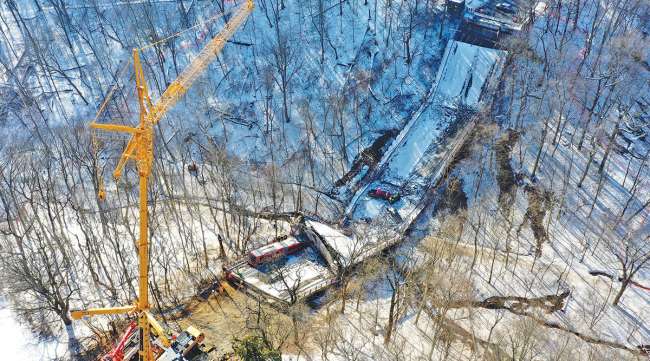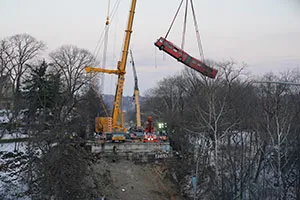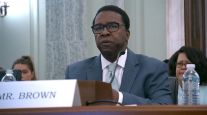Pittsburgh Post-Gazette
NTSB: Negligence Led to 2022 Pittsburgh Bridge Collapse

[Stay on top of transportation news: Get TTNews in your inbox.]
The Fern Hollow Bridge should have been shut down years before widespread corrosion and section loss caused a spectacular collapse in 2022 that severely injured several commuters and thrust Pittsburgh’s infrastructure woes into the spotlight, National Transportation Safety Board investigators said in a hearing Feb. 21.
For years, city officials failed repeatedly to address critical recommendations that were outlined in inspection reports from 2005 to 2021, which led to severe deterioration of the legs and the eventual failure of the bridge that carried 14,000 travelers each day, according to investigators.
Investigators also said the load rating — which indicates the amount of weight a bridge can safely handle — was far too high and should have been reduced.
“This bridge didn’t collapse just by an act of God,” said Michael Graham, an NTSB board member. “It collapsed because of a lack of maintenance and repair.”
As part of its comprehensive investigation — which is expected to be released fully next month — the NTSB found the city’s bridge inspection program was “ineffective,” calling it “poor quality,” and far outside the bounds of federal and industry standards.
Oversight of the city’s inspection regime by the Pennsylvania Department of Transportation and the Federal Highway Administration was also “insufficient,” said Jennifer Homendy, chair of the NTSB.
Homendy began the meeting by apologizing to the Pittsburgh community and those who were on the bridge that day.
“The Fern Hollow Bridge collapse should never have happened,” she said. “We are so sorry you experienced such a terrifying event.”
During the 3½-hour virtual meeting, the three board members — Homendy, Graham and Tom Chapman — voted unanimously to adopt the proposed findings and recommendations.
COMTO's April Rai offers tips to increase workforce diversity and grow profits.. Tune in above or by going to RoadSigns.ttnews.com.
To prevent future tragedies, the NTSB recommended several changes at all levels of government: The city needs to keep more detailed records of repairs, and work with the Pennsylvania Department of Transportation to develop a routine maintenance program; PennDOT should publish yearly data on bridge deficiencies and repair recommendations; and the Federal Highway Administration should conduct a targeted review of safety issues presented in the Feb. 21 meeting.
The NTSB investigates transportation disasters, but doesn’t have enforcement powers, so it can’t compel the government agencies to follow its recommendations.
Year after year, the city was alerted to a rash of problems with the Fern Hollow Bridge: widespread corrosion, holes and up to 50% section loss in the legs. The root cause, inspectors say, was the clogged drainage system that allowed water to seep through the span and give way to rust and structural decay, which ultimately led to collapse.
For more than a decade, the city had no routine program in place to service the bridge, and only cleaned the drainage system once in 17 years, according to inspections records presented at the hearing that date back to 2005. Experts recommend cleaning drainage systems at least once a year.
“It was failure after failure after failure,” Homendy said. “From the local government to the state to the Federal Highway Administration.”
Ultimately, “The City of Pittsburgh was responsible for inspecting and maintaining the Fern Hollow Bridge,” said NTSB engineer Dan Walsh. Investigators tried to find out why local officials failed to remediate Fern Hollow for so long, but the city’s records documenting the work performed were “limited” and “provided little information.”
NTSB and PennDOT officials have slowly released thousands of pages of evidence since the span fell into a ravine in Frick Park on Jan. 28, 2022, but the definitive cause of the collapse has eluded the public until now.

A crane frees a trapped bus on the Fern Hollow Bridge when it collapsed in 2022. (Gene J. Puskar/Associated Press)
Throughout the Feb. 21 hearing, NTSB officials outlined a slew of concerns: a porous inspection process that missed glaring deficiencies, inadequate maintenance and failures by the city and state to respond in a timely manner to urgent alerts.
Inspectors hired by PennDOT routinely failed to clean corrosion on the bridge’s legs, accurately rate its condition or recommend a structural review. An inspection performed four months before the collapse rated the bridge as “structurally deficient” — a 4 on a 9-point scale — but investigators said the rating should have been lower.
PennDOT not only had access to the same troubling reports as the city, but contracted with private companies to carry out the inspections.
The span had been rated in poor condition since 2011, but no significant repairs were made in the decade before it collapsed.
As the bridge gradually deteriorated, officials should have lowered its load rating, board members said. In 2014, the city posted a maximum load of 26 tons, but by the time the bridge caved in, the proper load rating would have been three tons, meaning it wasn’t safe to carry much traffic at all, Walsh said.
“Had contractors for the City of Pittsburgh correctly calculated and accounted for the effects of section loss and other factors back in 2014, the Fern Hollow Bridge would have, should have been closed,” Homendy said.
Just before dawn on the day of the collapse, the bridge’s southwest leg — which inspections show had large holes and heavy section loss — bent so far that it was near horizontal, destabilizing the structure and causing it to crumble, investigators revealed for the first time on Feb. 21.
While the southwest leg was in the worst shape, all four legs had been seriously damaged for years, but were never identified as fracture critical.
Had the legs been flagged and repaired, the span would never have caved in, investigators said.
Want more news? Listen to today's daily briefing above or go here for more info
“Everybody wants to build and nobody wants to do maintenance,” said Homendy.
A Post-Gazette investigation just months after the collapse found the city was alerted to repairs that needed to be made dating to 1995 — some for just hundreds of dollars — but the work was never performed.
The revelations from the Feb. 21 meeting come as the city grapples with the deterioration of bridges in virtually every neighborhood, and soaring costs for repairs. The city owns 147 bridges, with 22 in poor condition — a number unchanged since Fern Hollow crumbled to the ground.
Out of all 50 states, Pennsylvania has the sixth most bridges rated in poor condition — about 3,000 — state data shows.
Mayor Ed Gainey has made efforts to improve the city’s bridge maintenance and repair programs. In the past two years, the city has added five new positions to the Bridges and Structures Division, new funding for maintenance, and completed joint flushing and scupper repairs for at least 25 bridges — work that inspectors say could have guarded against Fern Hollow’s structural decay.
“We continue to set up structures to ensure we don’t ever have to wake up to that nightmare again,” Gainey said Feb. 21.
Between August 2022 and July 2023, the city spent $1.27 million on bridge repairs, more than quadruple what it had spent in the last four years combined. That barely makes a dent in the city’s infrastructure woes — a private consultant hired by the city estimated that urgent repairs could cost up to $11.7 million.
But what’s certain, inspectors told NTSB investigators, is that routinely maintaining bridges could prevent millions of dollars in damages — along with bridge closures and collapses — in the future.
“The Fern Hollow catastrophe was a serious wake-up call for both the city of Pittsburgh and PennDOT,” Homendy said. “We cannot take infrastructure for granted. Lives depend on it.”
Staff Writer Laura Esposito contributed reporting.
Distributed by Tribune Content Agency, LLC





